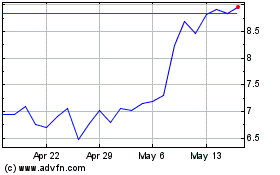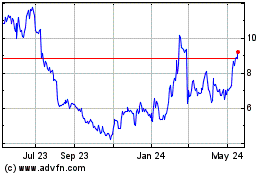Inogen Announces Publication of Study Demonstrating the Association of Portable Oxygen Therapy with Decreased Mortality and Increased Cost-Effectiveness Ratio
04 June 2024 - 6:05AM
Business Wire
Inogen, Inc. (Nasdaq: INGN), a medical technology company
offering innovative respiratory products for use in the homecare
setting, today shared the results of a study published in the
journal Pulmonary Therapy, demonstrating the association of
portable oxygen concentrators with increased survival and
cost-effectiveness ratio when compared to other long-term oxygen
therapies.
The study sourced data from the French national healthcare
system database, the Système National des Données de Santé (SNDS).
With a sample size of over 244,000 adult long-term oxygen therapy
patients from 2013-2020, it is likely the largest retrospective
claims database assessment study of long-term oxygen therapy to
date. The results showed that portable oxygen concentrator (POC)
use, either alone or in combination with other oxygen modalities,
was associated with improved survival and similar healthcare
resource use, such as hospitalizations and specialist visits,
compared to stationary concentrators, compressed tanks and liquid
oxygen. Additionally, based on the incremental cost-effectiveness
ratio (ICER), POCs were cost-effective compared to stationary
concentrators, compressed tanks, and liquid oxygen.
In a secondary analysis of the POC group, two sub-groups were
classified based on device autonomy i.e. higher mobility and lower
mobility groups. The higher mobility POC sub-group were allocated
Inogen devices and had an autonomy greater than 5 hours, while the
lower mobility POC sub-group were allocated non-Inogen devices and
had an autonomy less than 5 hours. Within the POC group, the higher
mobility POC sub-group were associated with better survival, lower
healthcare resource use and lower related costs vs the lower
mobility POC sub-group.
“The study highlights what we have known anecdotally about
portable oxygen therapies, and Inogen devices,” said Kevin Smith,
President and Chief Executive Officer. “We have long believed that
mobile oxygen therapies, primarily portable oxygen concentrators,
are associated with improved health outcomes, affordability, and
patient quality of life. We are proud that this study confirms the
value proposition of our devices. Looking forward, we will continue
to expand the adoption of our effective and high-quality POCs,
enabling even more patients to experience these benefits.”
To read the published study, please visit:
https://link.springer.com/article/10.1007/s41030-024-00259-x
About Inogen
Inogen, Inc. (Nasdaq: INGN) is a leading global medical
technology company offering innovative respiratory products for use
in the homecare setting. Inogen supports patient respiratory care
by developing, manufacturing, and marketing innovative
best-in-class portable oxygen concentrators used to deliver
supplemental long-term oxygen therapy to patients suffering from
chronic respiratory conditions. Inogen partners with patients,
prescribers, home medical equipment providers, and distributors to
make its oxygen therapy products widely available allowing patients
the chance to remain ambulatory while managing the impact of their
disease.
For more information, please visit www.inogen.com.
Inogen has used, and intends to continue to use, its Investor
Relations website, http://investor.inogen.com/, as a means of
disclosing material non-public information and for complying with
its disclosure obligations under Regulation FD.
Forward-Looking Statements
This press release contains forward-looking statements within
the meaning of the Private Securities Litigation Reform Act of
1995, including, among others, statements with respect to the
future results associated with the clinical study, and increased
adaptation of Inogen devices. Any statements contained in this
communication that are not statements of historical fact may be
deemed to be forward-looking statements. Words such as “believes,”
“anticipates,” “plans,” “expects,” “will,” “intends,” “potential,”
“possible,” and similar expressions are intended to identify
forward-looking statements. Forward-looking statements are subject
to numerous risks and uncertainties that could cause actual results
to differ materially from currently anticipated results, including
but not limited to, risks related to its announced management and
organizational changes, and risks arising from the possibility that
Inogen will not realize anticipated future financial performance or
strategic goals. In addition, Inogen's business is subject to
numerous additional risks and uncertainties, including, among
others, risks relating to market acceptance of its products;
competition; its sales, marketing and distribution capabilities;
its planned sales, marketing, and research and development
activities; interruptions or delays in the supply of components or
materials for, or manufacturing of, its products; seasonal
variations; unanticipated increases in costs or expenses; risks
associated with international operations; and the possibility that
Inogen will not realize anticipated revenue from recent or future
technology acquisitions or that expenses and costs related thereto
will exceed Inogen’s expectations. Information on these and
additional risks, uncertainties, and other information affecting
Inogen’s business operating results are contained in its Annual
Report on Form 10-K for the period ended December 31, 2023, its
Quarterly Report on Form 10-Q for the calendar quarter ended March
31, 2024 and in its other filings with the Securities and Exchange
Commission. These forward-looking statements speak only as of the
date hereof. Inogen disclaims any obligation to update these
forward-looking statements except as may be required by law.
View source
version on businesswire.com: https://www.businesswire.com/news/home/20240603365310/en/
ir@inogen.net
Inogen (NASDAQ:INGN)
Historical Stock Chart
From May 2024 to Jun 2024

Inogen (NASDAQ:INGN)
Historical Stock Chart
From Jun 2023 to Jun 2024
